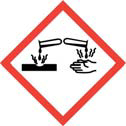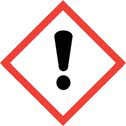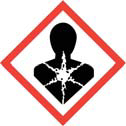
AC•Tech 2170 FC, Part B
SECTION 1: Identification of the Substance/Mixture and of the Company/Undertaking
1.1 Product Identifier
AC•Tech 2170 FC, Part B
1.2 Relevant identified uses of the substance or mixture and uses advised against
Use of the substance/mixture
Chemical product for construction and industry
1.3 Details of the supplier of the safety data sheet
Manufacturer: Allied Construction Technologies, Inc. – Phone:(757)-855-5100
3302 Croft Street – Email: Team@actechperforms.com
Norfolk, VA 23513
Emergency Phone:
US & Canada – Infotrac: (800) 535-5053
International – Infotrac: 1-352-323-3500
(Contract #104212)
SECTION 2: Hazards Identification
2.1 Classification of the substance or mixture
Classification according to Directive 67/548/EEC or 1999/45/EC
Indications of danger: C – Corrosive, Xn – Harmful, Xi – Irritant
R phrases:
Possible risk of impaired fertility.
Harmful if swallowed.
Causes burns.
Irritating to respiratory system.
May cause sensitization by skin contact.
Harmful to aquatic organisms, may cause long-term adverse effects in the aquatic environment.
Classification according to Regulation (EC) No. 1272/2008 [CLP]
Hazard categories:
Skin corrosion/irritation: Skin Corr. 1A
Serious eye damage/eye irritation: Eye Dam. 1
Respiratory/skin sensitization: Skin Sens. 1
Reproductive toxicity: Repr. 2
Specific target organ toxicity – single exposure: STOT SE 3
Hazardous to the aquatic environment: Aquatic Chronic 3
Hazard Statements:
Causes severe skin burns and eye damage.
May cause an allergic skin reaction.
May cause respiratory irritation.
Suspected of damaging fertility. Suspected of damaging the unborn child.
Harmful to aquatic life with long lasting effects.
2.2 Label Elements
Hazardous components which must be listed on the label
m-phenylenebis (methylamine)
4-tert-butylphenol
trimethylhexane-1,6-diamine
Signal word: Danger
Pictograms: GHS05-GHS07-GHS08



Hazard statements
H314 Causes severe skin burns and eye damage.
H317 May cause an allergic skin reaction.
H335 May cause respiratory irritation.
H361fd Suspected of damaging fertility. Suspected of damaging the unborn child.
H412 Harmful to aquatic life with long lasting effects.
Precautionary statements
P280 Wear protective gloves/protective clothing/eye protection/face protection.
P305+P351+P338 IF IN EYES: Rinse cautiously with water for several minutes. Remove contact lenses, if
present and easy to do. Continue rinsing.
P308+P313 IF exposed or concerned: Get medical advice/attention.
P310 Immediately call a POISON CENTER/doctor.
NFPA and HMIS Rating
| NFPA Rating | Health: 2 | Fire: 1 | Reactivity: 0 |
|---|---|---|---|
| HMIS Rating | Health: 2 | Flammability: 1 | Physical Hazard: 0 |
SECTION 3: Composition/Information on Ingredients
3.1 Mixtures
Hazardous Components

For Full text R-,H- and EUH-phrases: see section 16.
SECTION 4: First Aid Measures
4.1 Description of first aid measures
General Information
Change contaminated clothing. If you feel unwell due to accidental exposure, seek medical attention immediately.
(show MSDS if possible)
After inhalation
Move to fresh air and keep warm and rest.
After contact with skin
After contact with skin, take off immediately all contaminated clothing, and wash immediately with plenty of water and
soap. In case of skin irritation, seek medical treatment.
After contact with eyes
In case of contact with eyes, rinse immediately with plenty of fl owing water for 10 to 15 minutes holding eyelids apart.
Consult an ophthalmologist.
After ingestion
If swallowed, rinse mouth with water (only if the person is conscious) . Sip water. Do not induce vomiting.
Immediately get medical attention.
SECTION 5: Firefighting Measures
5.1 Extinguishing media
Suitable extinguishing media
– alcohol resistant foam.
– Water spray.
– Carbon dioxide (CO2).
– dry extinguishing powder.
Unsuitable extinguishing media
-High power water jet.
5.2 Special hazards arising from the substance or mixture
Can be released in case of fire:
-Carbon monoxide
-Carbon dioxide
-Nitrogen oxides (NOx).
5.3 Advise for firefighters
In case of fire: Wear self-contained breathing apparatus.
Additional information
Collect contaminated fire extinguishing water separately. Do not allow entering drains or surface water.
SECTION 6: Accidental Release Measures
6.1 Personal precautions, protective equipment and emergency procedures
Wear personal protection equipment. See protective measures under point 7 and 8. Provide adequate ventilation.
6.2 Environmental precautions
Do not empty into drains or the aquatic environment. Cover drains. Clean contaminated objects and areas thoroughly
observing environmental regulations. In case of gas being released or leakage into waters, ground or the drainage
system, the appropriate authorities must be informed.
6.3 Methods and material for containment and cleaning up
Absorb with liquid-binding material (e.g. sand, diatomaceous earth, acid- or universal binding agents). Remove
mechanically, placing in appropriate containers for disposal.
6.4 References to other sections
Personal protection equipment refer to chapter 8.
SECTION 7: Handling and Storage
7.1 Precautions for safe handling
Wear protective clothing. Close container tightly once it is no longer in use. Store away from direct sunlight, heat,
spark, fire and other sources of ignition. Empty containers may still contain mixed or unmixed materials, which may
be hazardous.
7.2 Storage
Keep in closed, original container. Store container in a cool, dry and ventilated area. Protect from direct sunlight an
heat or heating elements. Do not store near spark, fi re and other sources of ignition. Keep away from food,
beverages and animal feed. Keep away from oxidizing agents. Protect from frost, humidity and heat.
SECTION 8: Exposure Controls/Personal Protection
8.1 Exposure Limits & Controls
OSHA
No limit values from OSHA. Use in a well-ventilated area.
Skin Protection
Use protective clothing to prevent skin contact. Wear nitrile or butyl rubber gloves. Ensure the chemical resistance of
the gloves is suitable for use with these chemicals.
Eye Protection
Wear tight-fitting, protective goggles or face shield.
Respiratory Protection
When applying material in confined spaces, use appropriate NIOSH mask. When applying in vented spaces,
respiratory protection is not required unless there are sensitivities to chemicals listed in MSDS.
Body Protection
For protection against direct skin contact, ensure protective clothing covers all exposed skin areas.
General Protection & Hygiene
Avoid contact with skin, eyes and clothing. In case of skin sensitivity, protect skin with protective skin cream. Remove
contaminated clothing immediately. Do not eat, drink or smoke in or around application area. Wash hands
before taking breaks and at the end of application.
SECTION 9: Physical and Chemical Properties
Physical State: Liquid
Color: Light Yellow
Odor: Low
PH-Value: 12
Changes in physical state
Melting point No Data Available
Initial Boiling point and boiling range > 392 °F
Sublimation point No Data Available
Softening point No Data Available
Pour Point No Data Available
Flash point: > 212 °F
Flammability
Solid No Data Available
Gas No Data Available
Lower explosion limits No Data Available
Upper explosion limits No Data Available
Ignition temperature > 662 °F
Auto-ignition temperature
Solid No Data Available
Gas No Data Available
Decompression Temperature No Data Available
Vapor Pressure No Data Available
Density at 73 °F ~1.0 g/cm3
Partition coefficient: No Data Available
Viscosity/Dynamic (at 73 °F) ~700 CPS
Viscosity/Kinematic No Data Available
Flow Time No Data Available
Vapor Density No Data Available
Evaporation Rate No Data Available
SECTION 10: Stability and Reactivity
10.1 Reactivity
No dangerous reactions by handling and stock-keeping according to the guidelines.
10.2 Chemical Stability
No decomposition if used according to guidelines.
10.3 Possibility of hazardous reactions
No Data Available
10.4 Conditions to avoid
No Data Available
10.5 Incompatible materials
No Data Available
10.6 Hazardous decomposition products
No Data Available
SECTION 11: Toxicological Information
11.1 Information on toxicological effects
Acute toxicity
Based on available data, the classification criteria are not met.
Acute toxicity

Irritation and corrosivity
Causes severe skin burns and eye damage.
Sensitizing effects
May cause an allergic skin reaction. (m-phenylenebis(methylamine)), (trimethylhexane-1,6-diamine)
May cause heavy allergic reactions with chronic effects after a sensitization and a later exposure by very low
amounts.
STOT-single exposure
May cause respiratory irritation. (4-tert-butylphenol)
Severe effects after repeated or prolonged exposure
Based on available data, the classification criteria are not met.
Carcinogenic/mutagenic/toxic effects for reproduction
Suspected of damaging fertility. Suspected of damaging the unborn child.
Aspiration hazard
Based on available data, the classification criteria are not met.
Observations relevant to classification
Sensitization/Irritant effect on the respiratory tract: May cause allergy or asthma symptoms or breathing difficulties if
inhaled.
SECTION 12: Ecological Information
12.1 Toxicity

12.2 Persistence and degradability
No information available.
12.3 Bioaccumulative potential
No information available.
12.4 Mobility in soil
No information available.
12.5 Results of PBT and vPvB assessment
No information available.
Further Information
Harmful to aquatic life with long lasting effects. Do not empty into drains or the aquatic environment.
SECTION 13: Disposal Considerations
13.1 Product Disposal
Containers that have been completely emptied may be recycled per federal, state and local regulations and disposal
guidelines. Containers that have no been emptied or contain product residue may still contain hazardous
materials and should be disposed of in accordance with federal, state and local regulations regarding hazardous
material disposal.
SECTION 14: Transportation Information
Land transport (ADR/RID)
14.1. UN number: – UN 2735
14.2. UN proper shipping name: – AMINES, LIQUID, CORROSIVE, N.O.S. (m-phenylenebis(methylamine))
14.3. Transport hazard class(es): – 8
14.4. Packing group: – II
Hazard label: 8
Classification code: C7
Special Provisions: 274
Limited quantity: 1 L
Transport category: 2
Hazard No: 80
Tunnel restriction code: E
Other applicable information (land transport): – E2
Inland waterways transport (ADN)
14.1. UN number: – UN 2735
14.2. UN proper shipping name: – AMINES, LIQUID, CORROSIVE, N.O.S. (m-phenylenebis(methylamine))
14.3. Transport hazard class(es): – 8
14.4. Packing group: – II
Hazard label: 8
Classification code: C7
Special Provisions: 274
Limited quantity: 1 L
Other applicable information (inland waterways transport): – E2
Marine transport (IMDG)
14.1. UN number: – UN 2735
14.2. UN proper shipping name: – AMINES, LIQUID, CORROSIVE, N.O.S. (m-phenylenebis(methylamine))
14.3. Transport hazard class(es): – 8
14.4. Packing group: – II
Hazard label: 8
Marine pollutant: no
Special Provisions: 274
Limited quantity: 1 L
EmS: F-A, S-B
Other applicable information (marine transport): – E2
Air transport (ICAO)
14.1. UN number: – UN 2735
14.2. UN proper shipping name: – AMINES, LIQUID, CORROSIVE, N.O.S. (m-phenylenebis(methylamine))
14.3. Transport hazard class(es): – 8
14.4. Packing group: – II
Hazard label: 8
Special Provisions: A3 A803
Limited quantity Passenger: 0.5 L
IATA-packing instructions – Passenger: 851
IATA-max. quantity – Passenger: 1
LIATA-packing instructions – Cargo: 855
IATA-max. quantity -Cargo: 30 L
Other applicable information (air transport): – E2
: Y840
14.5. Environmental hazards
ENVIRONMENTALLY HAZARDOUS: no
SECTION 15: Regulatory Information
15.1. Safety, health and environmental regulations/legislation specific for the substance or mixture
National regulatory information
Water contaminating class (D): 2 – water contaminating
SECTION 16: Other Information
Relevant R-phrases (Number and full text)
20/22 Harmful by inhalation and if swallowed.
22 Harmful if swallowed.
34 Causes burns.
35 Causes severe burns.
37/38 Irritating to respiratory system and skin.
41 Risk of serious damage to eyes.
43 May cause sensitization by skin contact.
51 Toxic to aquatic organisms.
52 Harmful to aquatic organisms.
53 May cause long-term adverse effects in the aquatic environment.
62 Possible risk of impaired fertility.
Relevant H- and EUH-phrases (Number and full text)
H302 Harmful if swallowed.
H314 Causes severe skin burns and eye damage.
H315 Causes skin irritation.
H317 May cause an allergic skin reaction.
H318 Causes serious eye damage.
H332 Harmful if inhaled.
H335 May cause respiratory irritation.
H361 Suspected of damaging fertility or the unborn child.
H361fd Suspected of damaging fertility. Suspected of damaging the unborn child.
H411 Toxic to aquatic life with long lasting effects.
H412 Harmful to aquatic life with long lasting effects.
Further Information
To the best of our knowledge, the information contained in this MSDS is accurate. It is intended to assist the user in
his evaluation of the product’s hazards, and safety precautions to be taken in its use. The data on this MSDS
relate only to the specific material designated herein. We do not assume any liability for the use of, or reliance on
this information, nor do we guarantee its accuracy or completeness.
